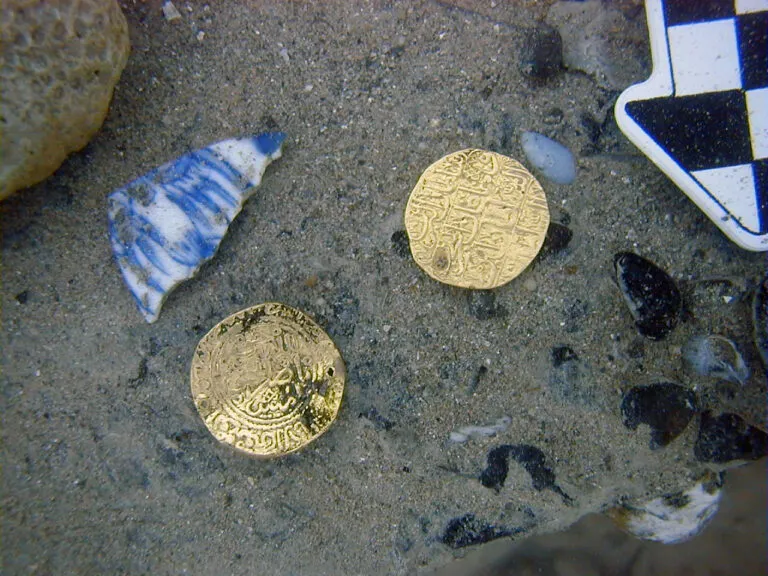Archaeologists Find 300-Year-Old Shipwreck in What Used to Be ‘One of the Baddest Pirate Lairs on Earth’
Pirates attacked the Portuguese warship, named the “Nossa Senhora do Cabo,” and made off with many of the treasures the ship was transporting from India to Portugal

After years of research, archaeologists think they have discovered the remains of a lost ship that was attacked by pirates more than 300 years ago.
They say they’ve located the vessel—a Portuguese warship called Nossa Senhora do Cabo—near Madagascar, the island nation off the southeastern coast of Africa.
Nossa Senhora do Cabo, which translates to Our Lady of the Cape, is resting on the seafloor near Nosy Boraha, a small island off Madagascar’s east coast, reports Live Science’s Tom Metcalfe.
/https://tf-cmsv2-smithsonianmag-media.s3.amazonaws.com/filer_public/69/ed/69ed04f4-abf5-4849-be75-95b677a84459/field_work-2.jpg)
Researchers with the Massachusetts-based Center for Historic Shipwreck Preservation confirmed the vessel’s identity by analyzing historic documents, the size and shape of the hull, and the artifacts found nearby. Brandon Clifford, the center’s director and co-founder, and Mark Agostini, an archaeologist at Brown University, describe the find in the June issue of Wreckwatch magazine.
The Nossa Senhora do Cabo departed on her ill-fated final voyage from Goa to Lisbon in early 1721, when Goa was a Portuguese colony. The ship was transporting a variety of treasures from India, including gold and silver bars, textiles, jewels and religious artifacts. Archaeologists estimate the trove would be worth approximately $138 million today.
The outgoing Portuguese viceroy and the archbishop of Goa were also on board, along with approximately 200 enslaved individuals from Mozambique.
/https://tf-cmsv2-smithsonianmag-media.s3.amazonaws.com/filer_public/9d/93/9d9313a0-cd84-4e14-97c1-7bd340b0d017/fig_8-768x394.jpg)
On April 8, 1721, pirates surrounded the 700-ton vessel while it was anchored near Réunion Island in the Indian Ocean. The Nossa Senhora do Cabo’s crew members couldn’t put up much of a fight: The vessel had been battered by a storm, and they had been forced to toss many of its cannons overboard to keep it afloat.
The raiders—including pirates Olivier Levasseur and John Taylor—sailed the Nossa Senhora do Cabo roughly 400 miles west toward Île Sainte-Marie. It was “one of the most dramatic episodes in all the wild years of the Golden Age of Piracy,” the researchers write in Wreckwatch magazine.
Quick fact: Who was Olivier Levasseur?
Known as “La Buse” (“The Buzzard”), Levasseur was a French pirate who was infamous for his relentless raids in the early 18th century.During the early 18th century, Île Sainte-Marie—now called Nosy Boraha—was a popular base for European pirates because of its proximity to major shipping lanes, its natural harbors and its lack of government oversight. At the time, the area was “one of the baddest pirate lairs on Earth, where legal traders never dared visit,” the researchers write in Wreckwatch magazine.
Once the pirates hauled off most of the Nossa Senhora do Cabo’s loot, they “needed to get rid of the evidence,” so they intentionally sunk the vessel, the researchers write. What happened to the enslaved individuals or the Archbishop of Goa isn’t clear, though the viceroy was ransomed for $2,000.
However, the pirates didn’t make off with all the Nossa Senhora do Cabo’s treasures. Researchers have recovered more than 3,300 artifacts from the wreck, including gold coins inscribed with Arabic, pieces of porcelain and religious figurines. They also found an ivory plaque with gold letters spelling out “INRI,” an abbreviation of the Latin phrase that means “Jesus of Nazareth, King of the Jews.”
Scientists may not recover additional artifacts from the wreck, as it’s now mostly covered in sand and silt, per Live Science. But they say at least four other pirate-plundered shipwrecks are lying on the seafloor near Île Sainte-Marie, just waiting to be explored.
/https://tf-cmsv2-smithsonianmag-media.s3.amazonaws.com/accounts/headshot/SarahKuta.png)
